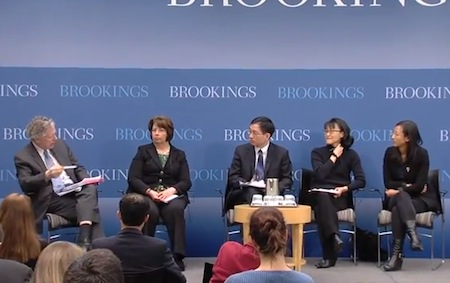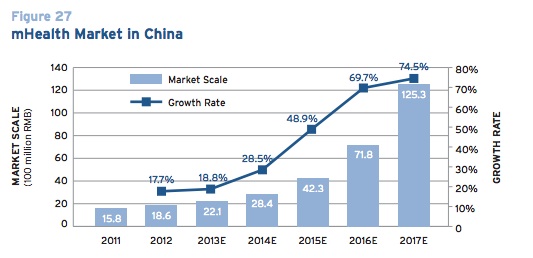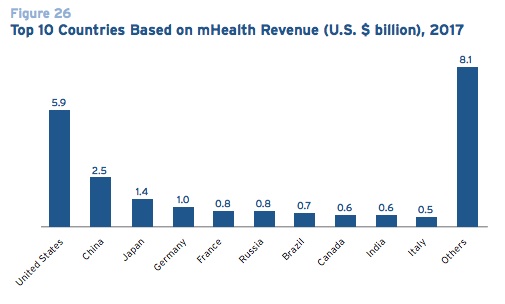 Left to Right: Darrell West, Gigi Sorenson, Xiaohui Yu, a translator, and Haihua Li
Left to Right: Darrell West, Gigi Sorenson, Xiaohui Yu, a translator, and Haihua Li
The Chinese mobile health market is estimated at 1.8 billion renminbi (RMB) or $291 million and research firm iiMedia predicts it will hit 12.5 billion RMB, or $2 billion in 2017, according to a new report from the Brookings Institution on mobile health in the United States and China. The report goes on to say that, according to GSM Association estimates, the United States and China will have the two biggest mobile health markets in 2017, accounting for more than a third of the world market between them.
"What impresses me is all the innovation and experimentation taking place in each country," Darrell West, Founding Director of the Brookings Center for Technology Innovation said in a panel discussion about the report held last week. "Each country is grasping with different aspects. There's lots of cool things happening. Each country is relatively early in the space, but given the projects taking place, there's good potential to learn from these and be in a stronger position in the future."
During the panel, American and Chinese speakers each talked about a mobile health case study in their country. Both studies focused on heart health. Gigi Sorensen, Northern Arizona Healthcare Director of Telehealth, spoke about a Flagstaff, Arizona trial called Care Beyond Walls and Wires, while Xiaohui Yu, Chief Engineer at the China Academy of Telecommunications Research of MIIT and Haihua Li, the vice chief engineer at the academy, talked about the Wireless Heart Health study in China.
In the Arizona pilot, 50 heart patients, many of whom lived in rural communities far from the hospital, were given wireless devices to track weight, blood pressure, and activity levels daily. The data was automatically transmitted to health providers, who could then follow up with tips and health advice.
The hospital system found, at the end of six months, that, compared to the six months prior to enrollment, these patients had fewer hospitalizations (an average of 1.82 versus 3.26) and fewer days hospitalized (an average of 5.13 versus 13.98). All in all, the hospital estimates it saved $92,317 per patient.
"The tools were cool, but if you add a nurse to it it's really cool," Sorenson said. "Using the technology and being able to have a person [virtually] in their home, just putting the technology there and being able to talk a patient through an anxiety was key. Our coordinator would say 'Just put on the pulse oximeter, let me talk to you, now look at that number, it's not that bad.' So just them seeing that and knowing you're not going to die in that moment, knowing you don't need to run to the emergency room, made a huge difference. Having that phone being able to transmit that data in a realtime fashion was critical."
 Sorenson said other facilities in the United States have already reached out to her for advice on implementing a similar program.
Sorenson said other facilities in the United States have already reached out to her for advice on implementing a similar program.
"The more you can talk to your administration and tell them 'This is not a revenue producing, but it's a cost saving initiative,' the better," she said. "And also to go one on one with physicians and saying 'Tell me why your patient shouldn't be in a program like this?' not 'Can I enroll your patient?'"
China's program was also designed to support rural communities that don't have access to the same care found in big cities. The program involved distributing a 3G system -- including smartphones with built-in ECG sensors, a web-based EMR software, and internet ready workstations -- to community health clinics in rural areas in China. Clinics used these tools to perform cardiovascular screenings on more than 10,000 patients, 1,700 of whom were referred to higher-level clinics for treatment.
"mHealth is still in its fledgling state in China, and so in the overall healthcare infrastructure it's still playing a very small role," Yu said via a translator. "However, I think mHealth is able to help us make two changes perhaps. In the past, when we talk about healthcare in China, the focus was on treatment. I think mHealth can move that focus to prevention and wellness. If we can do that it might bring down healthcare costs in China. Also in the past when we talked about healthcare, we also focused on hospitals. ... mHealth will help us move our focus from hospitals to the patients."
In both the United States and China, regulatory challenges have led to mobile health moving faster in the consumer wellness space than in the clinical health space. In the United States, some medical apps are regulated by the FDA, which relatively recently finalized guidelines on which apps need clearance. In China, regulations are more strict, as of now.
 "The Chinese Ministry of Health only allows consulting service through mobile devices," Li said. "We're not authorized to treat a patient or offer prescriptions."
"The Chinese Ministry of Health only allows consulting service through mobile devices," Li said. "We're not authorized to treat a patient or offer prescriptions."
Yu said the market is hungry for smartphone health engagement, though. He said the most popular consumer health app in China is a doctor consulting service. It boasts 10 million users and 500,000 engaged physicians.
China is also behind the United States in the adoption of electronic health records and the implementation of mobile broadband networks, two goals the country is currently working on that, when completed, could greatly speed the adoption of mobile health technologies.
"If we want to talk about applying our telemedicine to diagnostics at this point in time in China, we still have a lot of issues to tackle including legal issues and regulatory issues," Yu said. "But the good news is that the Chinese health authorities do believe mHealth is a tool to ensure that future healthcare resources will be distributed equally. So in the next few years we're going to have a program to specifically encourage telemedicine in China, and I think mHealth will be a part of that."
Correction: The original version of this article said the Chinese mobile health market was worth $291 billion, rather than $291 million.












